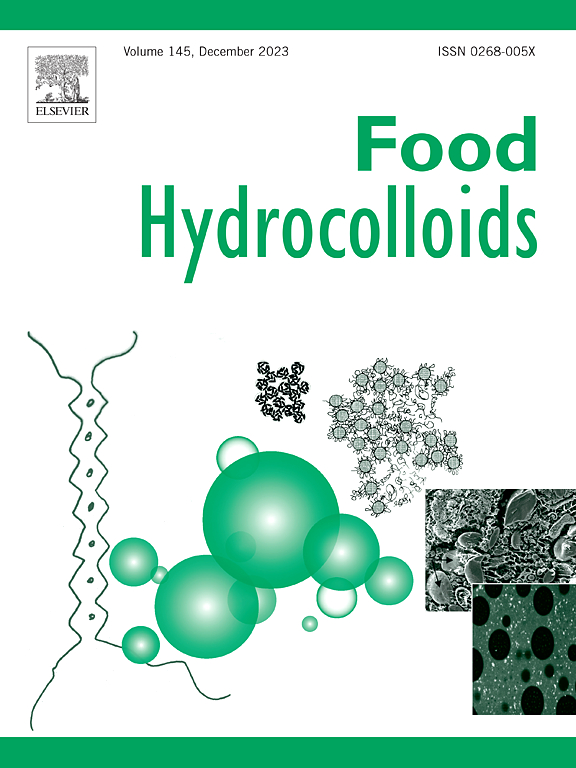Lowering the critical gelling concentration of soy protein via core-shell architecturing with chitosan
IF 11
1区 农林科学
Q1 CHEMISTRY, APPLIED
引用次数: 0
Abstract
Soy protein (SP) has been used extensively as an ingredient in the food industry because of its good gelling ability. In the present study, by introducing chitosan (CS), a novel SP-based mixture with largely improved gelling ability was successfully fabricated. Results showed that, driven by the electrostatic complexation and preheating treatment, the β-sheet structure maintaining SP's conformational integrity was disrupted, and the SP-CS complexes offered the masking effect on the protein's fluorescent groups. ζ-potential and X-ray photoelectron spectroscopy analyses indicated the formation of a core-shell structure with SP at the core and CS as the shell. This structure notably facilitated the formation of the SP-CS composite gel by increasing the hydrophobic aggregation of internal SP and inducing external CS molecular chains entanglement, even at a SP concentration as low as 3 % (w/v). The findings suggest that CS can markedly reduce the concentration of SP in composite gel, providing new insights for SP utilization in gel-based food processing.

壳聚糖核壳结构法降低大豆蛋白临界胶凝浓度
大豆蛋白因其良好的胶凝性能在食品工业中得到了广泛的应用。本研究通过引入壳聚糖(CS),成功制备了一种新型的sp基混合物,其胶凝能力大大提高。结果表明,在静电络合和预热作用下,维持SP构象完整性的β-片结构被破坏,SP- cs配合物对蛋白质的荧光基团具有掩蔽作用。ζ-电位和x射线光电子能谱分析表明,其形成以SP为核心,CS为壳层的核壳结构。即使在低至3% (w/v)的SP浓度下,该结构也通过增加内部SP的疏水聚集和诱导外部CS分子链纠缠,显著促进SP-CS复合凝胶的形成。研究结果表明,CS可显著降低复合凝胶中SP的浓度,为SP在凝胶食品加工中的利用提供了新的思路。
本文章由计算机程序翻译,如有差异,请以英文原文为准。
求助全文
约1分钟内获得全文
求助全文
来源期刊

Food Hydrocolloids
工程技术-食品科技
CiteScore
19.90
自引率
14.00%
发文量
871
审稿时长
37 days
期刊介绍:
Food Hydrocolloids publishes original and innovative research focused on the characterization, functional properties, and applications of hydrocolloid materials used in food products. These hydrocolloids, defined as polysaccharides and proteins of commercial importance, are added to control aspects such as texture, stability, rheology, and sensory properties. The research's primary emphasis should be on the hydrocolloids themselves, with thorough descriptions of their source, nature, and physicochemical characteristics. Manuscripts are expected to clearly outline specific aims and objectives, include a fundamental discussion of research findings at the molecular level, and address the significance of the results. Studies on hydrocolloids in complex formulations should concentrate on their overall properties and mechanisms of action, while simple formulation development studies may not be considered for publication.
The main areas of interest are:
-Chemical and physicochemical characterisation
Thermal properties including glass transitions and conformational changes-
Rheological properties including viscosity, viscoelastic properties and gelation behaviour-
The influence on organoleptic properties-
Interfacial properties including stabilisation of dispersions, emulsions and foams-
Film forming properties with application to edible films and active packaging-
Encapsulation and controlled release of active compounds-
The influence on health including their role as dietary fibre-
Manipulation of hydrocolloid structure and functionality through chemical, biochemical and physical processes-
New hydrocolloids and hydrocolloid sources of commercial potential.
The Journal also publishes Review articles that provide an overview of the latest developments in topics of specific interest to researchers in this field of activity.
 求助内容:
求助内容: 应助结果提醒方式:
应助结果提醒方式:


